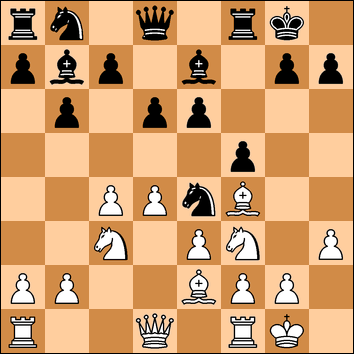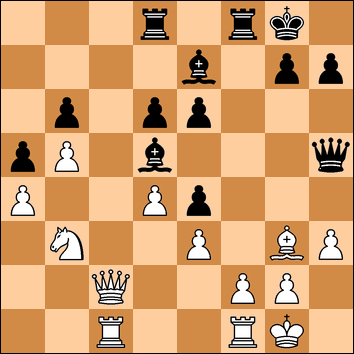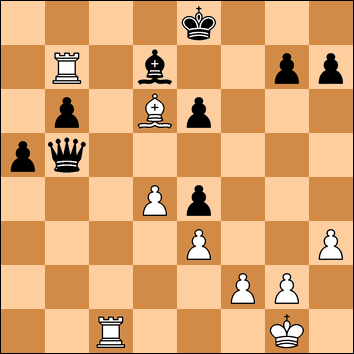Swale Club Chess Championship - Final Group - Round Seven
Thursday 20 June 2019
White: Rob Woolacott (142) - Black: Keith Nevols (163)
Dutch Defence
The last game of the championship. I was 1.5 points behind the two leaders so I knew I could not win the title. I had however played one game less so if I could win this one then I would at least have some bragging rights.
My opponent had defeated me earlier this season - my only loss - so I was keen for revenge.
1. Nf3 f5
2. d4 Nf6
3. c4 e6
4. Nc3 Be7
5. Bf4 d6
6. h3
A curious move, perhaps thinking of g4. As White will, presumably, not be fianchetto-ing his bishop then often in the Dutch defence, Black will aim to do so. This though is a mistake.
The engine recommends 6. .. Ne4 7. Nxe4 fxe4 8. Nd2 d5.
6. …. b6
7. e3 Bb7
8. Be2
8. Ng5! gives White the advantage. Black could retract with 8. .. Bc8 when 9. g4 looks good, or play 8. .. Qc8 when 9. d5 follows and the knight will be arriving on e6. It might have been wiser for Black to castle last move.
8. …. Ne4
9. O-O O-O

10. Nxe4
10. c5!? is an interesting temporary pawn sacrifice. After 10. .. bxc5 11. Qb3, White again zones in on the e6 pawn, meeting 11. .. Qc8 with 12. Bc4 (12. .. d5? 13. Nxd5 exd5 14. Bxd5+ Bxd5 15. Qxd5+ and Qxa8) or 10... Bc8 11. Bc4.
Blacks best might be 10. .. Nxc3 11. bxc3 bxc5.
10. …. fxe4
Taking with the bishop is an alternative but after 11. Nd2 Bb7 12. Bf3 I did not see the point. An open f-file with a well-placed pawn gives chances of attack.
11. Nd2 Nd7
12. Bg3
Missing the chance for 12. Bg4 which again would put Black in a pickle.
12. ….. Nf6
13. b4!
However, White finds a good plan. He uses his advantage in space to create a queenside attack.
13. …...Qe8
Meanwhile, Black is thinking of a kingside attack!
14. a4 a5
15. b5 Qg6
16. Nb3
Zoning in on the c5 spot.
16. ...… Rad8
17. Qc2 Nh5
Hoping to exchange one of the bishops to ease the queenside pressure.
18. Bxh5 Qxh5
19. c5!
White makes his move and opens the c-file.
19. …. Bd5
If I had allowed c6 then the bishop would look very silly.
20. cxb6 cxb6
21. Rac1

Now the crucial moment. White prepares to invade down the c-file. The recommendations are 21. .. Bh4 to try to exchange off a bishop pair, or 21. … Rb8 to defend the b6 square and meet 22. Qc7 with 22. .. Rb7.
Instead I make the calamitous decision to exchange the queen for the two rooks, and my position collapses with alarming speed.
21. …. Rc8??
22. Qxc8
For some reason I thought that White would not play this.
22. ..... Rxc8
23. Rxc8+ Kf7
24. Rc7!
A clever way to entice Black into another blunder. Black ought to move the king next when White will follow with 25. Nd2.
24. …..Bxb3?
25. Bxd6 Bxa4
I had hoped to be able to use the a-pawn for some counterplay but there is not the time for this.
26. Bxe7
26. Rxe7 is stronger although Black can resign now.
26. …. Ke8
27. Rfc1 Bxb5
28. Bd6 Bd7
29. Rb7 Qd5
This was the point of my ramshackle defence, thinking if I can hold on for the next few moves, then maybe I can get something going with the two queenside pawns.

30. Rb8+ Kf7
31. Be5 g5
32. Rc7 Kg6
33. Rd8
With the demise of the bishop, and the pairing up of the rooks on the seventh rank, I resigned.
The last game of the championship. I was 1.5 points behind the two leaders so I knew I could not win the title. I had however played one game less so if I could win this one then I would at least have some bragging rights.
My opponent had defeated me earlier this season - my only loss - so I was keen for revenge.
1. Nf3 f5
2. d4 Nf6
3. c4 e6
4. Nc3 Be7
5. Bf4 d6
6. h3
A curious move, perhaps thinking of g4. As White will, presumably, not be fianchetto-ing his bishop then often in the Dutch defence, Black will aim to do so. This though is a mistake.
The engine recommends 6. .. Ne4 7. Nxe4 fxe4 8. Nd2 d5.
6. …. b6
7. e3 Bb7
8. Be2
8. Ng5! gives White the advantage. Black could retract with 8. .. Bc8 when 9. g4 looks good, or play 8. .. Qc8 when 9. d5 follows and the knight will be arriving on e6. It might have been wiser for Black to castle last move.
8. …. Ne4
9. O-O O-O
10. Nxe4
10. c5!? is an interesting temporary pawn sacrifice. After 10. .. bxc5 11. Qb3, White again zones in on the e6 pawn, meeting 11. .. Qc8 with 12. Bc4 (12. .. d5? 13. Nxd5 exd5 14. Bxd5+ Bxd5 15. Qxd5+ and Qxa8) or 10... Bc8 11. Bc4.
Blacks best might be 10. .. Nxc3 11. bxc3 bxc5.
10. …. fxe4
Taking with the bishop is an alternative but after 11. Nd2 Bb7 12. Bf3 I did not see the point. An open f-file with a well-placed pawn gives chances of attack.
11. Nd2 Nd7
12. Bg3
Missing the chance for 12. Bg4 which again would put Black in a pickle.
12. ….. Nf6
13. b4!
However, White finds a good plan. He uses his advantage in space to create a queenside attack.
13. …...Qe8
Meanwhile, Black is thinking of a kingside attack!
14. a4 a5
15. b5 Qg6
16. Nb3
Zoning in on the c5 spot.
16. ...… Rad8
17. Qc2 Nh5
Hoping to exchange one of the bishops to ease the queenside pressure.
18. Bxh5 Qxh5
19. c5!
White makes his move and opens the c-file.
19. …. Bd5
If I had allowed c6 then the bishop would look very silly.
20. cxb6 cxb6
21. Rac1
Now the crucial moment. White prepares to invade down the c-file. The recommendations are 21. .. Bh4 to try to exchange off a bishop pair, or 21. … Rb8 to defend the b6 square and meet 22. Qc7 with 22. .. Rb7.
Instead I make the calamitous decision to exchange the queen for the two rooks, and my position collapses with alarming speed.
21. …. Rc8??
22. Qxc8
For some reason I thought that White would not play this.
22. ..... Rxc8
23. Rxc8+ Kf7
24. Rc7!
A clever way to entice Black into another blunder. Black ought to move the king next when White will follow with 25. Nd2.
24. …..Bxb3?
25. Bxd6 Bxa4
I had hoped to be able to use the a-pawn for some counterplay but there is not the time for this.
26. Bxe7
26. Rxe7 is stronger although Black can resign now.
26. …. Ke8
27. Rfc1 Bxb5
28. Bd6 Bd7
29. Rb7 Qd5
This was the point of my ramshackle defence, thinking if I can hold on for the next few moves, then maybe I can get something going with the two queenside pawns.
30. Rb8+ Kf7
31. Be5 g5
32. Rc7 Kg6
33. Rd8
With the demise of the bishop, and the pairing up of the rooks on the seventh rank, I resigned.